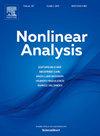Optimal decay and regularity for a Thomas–Fermi type variational problem
IF 1.3
2区 数学
Q1 MATHEMATICS
引用次数: 0
Abstract
We study existence and qualitative properties of the minimizers for a Thomas–Fermi type energy functional defined by where , , and is a potential. Under broad assumptions on we establish existence, uniqueness and qualitative properties such as positivity, regularity and decay at infinity of the global minimizer. The decay at infinity depends in a non-trivial way on the choice of and . If and the global minimizer is proved to be positive under mild regularity assumptions on , unlike in the local case where the global minimizer has typically compact support. We also show that if decays sufficiently fast the global minimizer is sign-changing even if is non-negative. In such regimes we establish a relation between the positive part of the global minimizer and the support of the minimizer of the energy constrained to the cone of non-negative functions. Our study is motivated by recent models of charge screening in graphene, where sign-changing minimizers appear in a natural way.
托马斯-费米型变分问题的最优衰减和正则性
我们研究由 Eα(ρ)≔1q∫Rd|ρ(x)|qdx+12∬Rd×Rdρ(x)ρ(y)|x-y|d-αdxdy-∫RdV(x)ρ(x)dx 定义的托马斯-费米型能量函数的最小值的存在性和定性性质、其中 d∈[2,∞),α∈(0,d),q∈(2dd+α,∞),V 是一个势。根据对 V 的宽泛假设,我们确定了全局最小值的存在性、唯一性和定性特性,如正向性、正则性和无穷大时的衰减。如果α∈(0,2)和q>2,全局最小值在 V 的温和正则性假设下被证明为正值,这与局部情况 α=2 不同,在局部情况下,全局最小值具有典型的紧凑支持。我们还证明,如果 V 的衰减速度足够快,即使 V 为非负,全局最小值也会发生符号变化。在这种情况下,我们建立了全局最小值的正向部分与约束于非负函数锥的能量最小值的支持之间的关系。我们的研究受到石墨烯中电荷筛选的最新模型的启发,在这些模型中,符号变化最小化以一种自然的方式出现。
本文章由计算机程序翻译,如有差异,请以英文原文为准。
求助全文
约1分钟内获得全文
求助全文
来源期刊
CiteScore
3.30
自引率
0.00%
发文量
265
审稿时长
60 days
期刊介绍:
Nonlinear Analysis focuses on papers that address significant problems in Nonlinear Analysis that have a sustainable and important impact on the development of new directions in the theory as well as potential applications. Review articles on important topics in Nonlinear Analysis are welcome as well. In particular, only papers within the areas of specialization of the Editorial Board Members will be considered. Authors are encouraged to check the areas of expertise of the Editorial Board in order to decide whether or not their papers are appropriate for this journal. The journal aims to apply very high standards in accepting papers for publication.

 求助内容:
求助内容: 应助结果提醒方式:
应助结果提醒方式:


